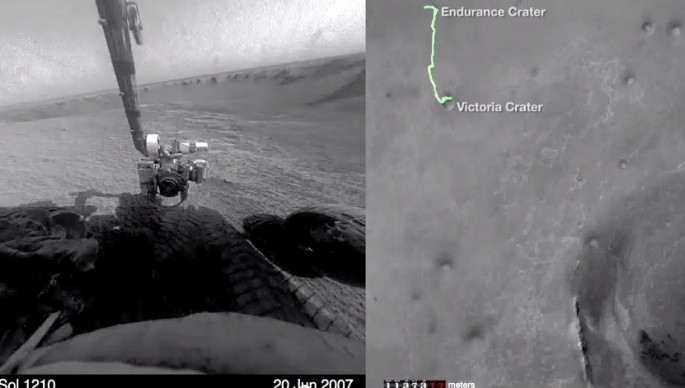NASA's Mars Opportunity rover just released a new, incredible eight minute time lapse video of its 11 years of journeying across Martian terrain and surface. The rover has been on the Red Planet since 2004.
This video was compiled by NASA Jet Propulsion Laboratory scientists using thousands of images in the past 11 years collected from the rover's Hazard-Avoidance cameras, providing unprecedented views of the planet.
Apart from amazing imagery, the scientists also created an audio track providing a soundtrack for the video from the rover's accelerometer. Sounds include synchronized louder, environmental sounds while Opportunity is traversing through rough terrain and softer sounds include muffled ones when the rover is going through sandy dunes.
The video spans the rover's travels from January 2004 since it landed on Mars up to April 2015 which covered a total of 26.2 miles which can be compared to a marathon distance for runners.
NASA's Mars Exploration Rover Project included not only the Opportunity rover but also its twin rover, Spirit, where both missions are just planned to last for just three months. However, Spirit rover only accomplished six years of scientific work before it finally stopped operations where Opportunity is still transmitting data and images, making the mission more than a success.
However, the rover has been in three weeks of hibernation mode due to its angle with the sun, making transmissions and communications difficult with Earth. This July, Opportunity will begin its trek again into "Marathon Valley" where it was named after its completion of its 26.2 mile Martian marathon.
This valley measures around 300 yards where some areas are thought to be exposed clay that can provide clues about water movement during Mars' history. During the Martian winter, Opportunity will still study the valley and its surrounding geological features amidst a sunny region.
Scientists prefer the rover to explore over sunny ares since NASA has already encountered technical problems with Opportunity's flash memory where the rover holds transmission the next day when it shuts down the night before.
Scientists say that this loss of telemetry data is the result of the rover's usage of its nonvolatile flash memory that causes random resets. To date, the rover is not using its flash memory for data transmission where it is now programmed to send data immediately when it collects them instead of storing it overnight.
Watch the eight minute time lapse video from the surface of Mars here, courtesy of NASA's Opportunity rover.



























